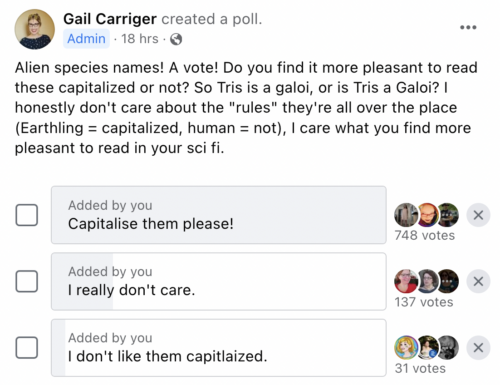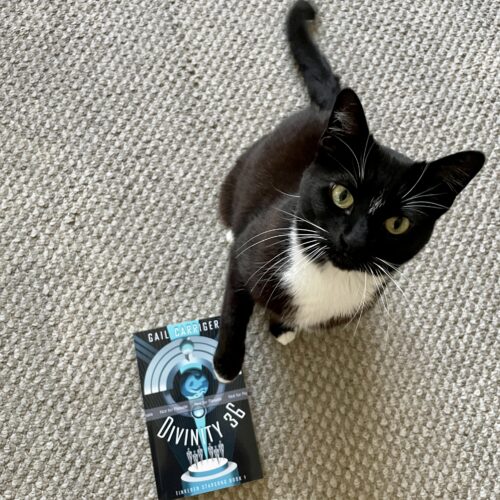How to say that alien name? That weird word Gail made up? And why did she do things the way she did?

Tinkered Starsong Pronunciation Guide!
Here’s a video of yours truly going though all the weird words in the Tinkered Starsong series and how to say them.*
Warning: It’s all the words in all three books.
If I think it’s a name that is easy to pronounce (e.g. Del) or based on an existing word and pronounced the same way it normally would be (e.g. Deducts) then I do not speak it in the above video.
For your convenience I include below a list of the words as I read them out, so you know what they look like on the page. If necessary (and for your amusement, avoiding spoilers) I include some extra notes next to some of the words. At the end are some more complicated world building thoughts on language and names and linguistics with aliens and future humans. If you want more encyclopedia style information on the different species (aka world bible) there is a wikia for that.
Unique Words in the Tinkered Stars Universe
Proper Names (words that are capitalized)
- Asterism
- Berril (Shawalee)
- Cassin (Sapien) (cantor) (Attacon Prime)
- Chalamee (sacerdote)
- Chaymay (Sapien) (Orrow) (high cantor)
- Errata (pantheon)
- Fandina (Dyesi)
- Fortew (low cantor) (Tillam)
- Gemma (Attacon 7) (cantor)
- Heshoyi (calator)
- Itrio (Sapien) (bodyguard for Fortew)
- Jinyesun (Dyesi)
- Jutte (grace)
- Kagee (Sapien) (high cantor) (Agatay)
- Kallow (Sapien) (low cantor)
- Kill’ki
- Korpuna (Cotylan)
- Kumaimi (Dyesi)
- Lenqihe (Dyesi sifter)
- Levin (first Endant, Diarch of Agatay)
- Lhar (cafe worker)
- Liera (Agatay)
- Melalan (Tillam sifter)
- Miramoe (first Modal, Diarch of Agatay)
- Missit (Sapien) (Tillam high cantor)
- Monji (grace)
- Nusplunder (spaceship)
- Ohongshe (precatio) (Dyesi)
- Orlol (Errata)
- Orrow (newer pantheon)
- Phex (Wheel low cantor)
- Pommey (light grace)
- Protan (Agatay)
- Quasilun (imago Dyesi) (Dyesi bodyguard)
- Seryloh (Dyesi sifter)
- Sharm (Dorien)
- Shawalee (species)
- Tarloun (god)
- Tern (Cotylan, from Cotilax) (Tillam light grace) (fold-theory physicist)
- Tillam (pantheon) (Missit, Fortew, Zil, Tern, Yorunlee, Melalan)
- Tyve (Jakaa Nova) (dark grace) (Zil’s sister) (skin dark magenta)
- Villi (Sapien)
- Wyn (Orrow dark grace)
- Xillon (pantheon)
- Yislofei (potential sifter)
- Yorunlee (Tillam sifter) (Dyesi)
- Zalihan (Dyesi who recruited Phex) (cousin to Ohongshe)
- Zil (Tillam dark grace) (Jakaa Nova) (Tyve’s brother)
Places, Planets, Species
- Agatay (planet) (also adj)
- Attacon (sector)
- Cotilax (planet)
- Cotyla | Cotylan (sector)
- Dorien (species)
- Dyesi, the (taller than humans, skin blue range and shimmering, huge eyes, six-fingered hands, pointed ears with fin-like crests) (language: Dyesi) (nb: it, itself)
- Dyesid Prime (Dyesi homeworld) (ringed)
- Galoi (species)
- Hominins (HS or H species classification) extensive genetic tinkering renders them distinct from original homo Sapiens
- Hu-core (territory)
- Hydrab (species)
- Jakaa Nova (species in Kill’ki Coalition)
- Kill’ki (species)
- Syrunid Prime (adj/demonym Syruni) (relatively close to Dyesid Prime)
- Suryni (species)
Concepts, cultural groups (made up, obscure & scientific words that are not capitalized)
- armiger (Wheel)
- calator (Dyesi)
- cantor (pantheon)
- carborg & cyborg
- chiropteran (winged humanoids)
- countervail (Kill’ki)
- crudrat (Wheel)
- diarch (Agatay)
- diefthyn (rank of acolyte) (focus on the artistic side of the divinity)
- imago (Dyesi)
- koriemin (spice)
- murmel (Wheel)
- precatio (rank of acolyte) (manages the pantheon)
- progenetor (Wheel)
- sacerdote (rank of acolyte) (worshiper management/interaction)
- saposi juice (Dyesi drink)
- scythers (Wheel)
- somaform
Other (words that actually exist but may be difficult to pronounce)
- affiliative
- aestheticists
- delineation
- dracohors
- FTL
- instar
- koel (songbird)
- sodorium lorithite
- wergild
Names in this Series – Cantor, Grace, Dyesi & Beyond
There is a mention in this book that Phex has “a grace name”
This is a Dyesi conceit on how they brand the different positions in a pantheon.
- Grace names = one syllable
- Cantor names = two syllable
- Dyesi names (all of them, even not in pantheons) = three syllable
Most of the names in this series are entirely made up but some of them do have secondary meaning, it’ll be difficult to tease out this time around since I rarely used Latin and I often used other languages or combinations of languages.
Linguistics & Culture in the Tinkered Starsong Series
Linguistic registers: formal/polite/high versus informal/casual/rude/low, are common in many languages including, once, English. Other less common registers include frozen, legal, written/verse, and royal. (Think about use of the royal we instead of I.) In English a lot of this is indicated by accent, but registers in will involve specific honorifics, pronouns, conjugations, and alternate sentence structure.
It’s not an entirely different language but is a different way of speaking that language. And most speakers will organically code switch, which is to say speak a different register with parents/elders, at school, in the work place, with friends, or with those younger than them.
- Sometimes register is indicated by pronoun use, like the Old English thee/thou instead of you, or Spanish tu instead of usted.
- Sometimes it is contained in verb conjugation, see Spanish tu vs usted conjugations.
- Sometimes there are particles in play, like the Thai krap/kha/ha/ja/etc…
- Sometimes it’s an applied honorific or extension of the familial, see Korean terms like hyung, Thai prefixes like Phi+Name, or Japanese suffixes like Name+san. The closest thing English has to this is use of words like Mr Mrs Mz or boss.
The Galactic Language
3 Galactic registers: In this universe, the Galactic language exists in three registers: common, standard, and diplomatic.
- Common is for general conversational parlance and will contain slang, regionalisms, and be less static and fixed, quicker to evolve, and relevant to a specific sector or planet.
- Standard is for trade, so more formalized and simplistic version of Common (less slang) the idea would be to avoid confusion more than anything.
- Diplomatic (or formal) incorporates highly polite language intended to take into account multiple cultures and concepts and give the least possible offense. When speaking Galactic the Dyesi always use this register, which I indicate through highly formal (somewhat stiff) sentence structure and lack of conjugations.
In Galactic, the Dyesi use and prefer the objectifying gender-neutral pronoun “it” the concept of which (for me, the author) comes from cultural anthropology.
Galactic pronouns: The idea that in galactic the first person (I/me/my) pronouns carry gender identity (as opposed to third person singulars they do in English e.g. she/he) comes from me studying Thai.
- In other words, the act of introducing oneself and using a personal pronoun (or particle) identifies ones own gender as part of saying that pronoun. (I is NOT gender neutral as it is in English unless you choose it to be.)
- This concept is very hard to get across in English. Especially from a narrator writing in third person.
- As a result, my POV character Phex always seems to know everyone’s gender identity.
It’s because the language people speak in the book is telling him (and therefore the narrator and reader) this information the moment a conversation starts.
The Dyesi Language
Dyesi pronouns: The Dyesi language itself contains no gendered pronouns. All pronouns in their language work the way I/you do in English. Instead they have lifestage pronouns, the pronoun changes after each instar and has nothing to do with biological sex or gender. (I know, imagine that?)
Dyesi Registers: In Dyesi, register is indicated by grammar and word placement, so a little like spoken Latin versus written Latin. Like in Latin, the Dyesi both decline and conjugate, so noun and verb sentence placement is flexible.
Dyesi language exists in 3 registers:
- child (skinless)
- acquired/taught (which Phex thinks of as 2 separate registers)
- and frozen (imago)
During Divinity 36 Phex thinks Dyesi exists only in 2 registers: formal & informal, turns out that’s just the nymphs trying to correlate to Galactic. Acquired/taught is what Phex learns through the course of the first and second books. He basically learns “taught Dyesi,” and evolves to the more flexible “acquired Dyesi” which allows him to move between the nymphs’ way of speaking seamlessly.
But this is less actually moving between formal/informal registers than it is simply knowing his relationship to all the other people in any given room and what version is appropriate given that relationship.
Frozen register is specifically used by younger life stages when talking to their elders, and skinless is for children talking to each other.
Dyesi Greetings:
Like everything else they have 3.
- A formalized physical acknowledgment of sentient personhood (like a bow or a handshake) which is the finger flick.
- A formal verbal salutation “Beautiful greetings” which indicates specific interest in skill sets by the divinity.
- The acknowledgment of the space: a ritualized greeting and self announcement upon entering a room. This idea comes, in part, from Japanese. Although the idea of stating your relationship and history with a space as part of that greeting is my own and is based on the Dyesi lack of doors and a cave dwelling culture. This also allows for immediate use of a first person pronoun, thus identification of life state (for dyesi) and gender (for everyone else).
More on Gail + Languages & Names?
- Foreign Editions: Everything You Ever Wanted to Know About Books in Translation
- Anglicization: In Which We Revisit the Ladybird Problem
- Pronouncing Names & the Meaning Behind Them, Plus How does Gail Choose Names?
- Why Gail uses the G.L. Carriger pen name.
* This whole post was drawn off of my copy editor’s style guide. Waves at Richard. I actually used the Tinkered Starsong series to talk about what a style guide/sheet is and what they look like in this blog post.
Divinity 36: DVD Extras!
- Official announcement & cover reveal: Gail has a new book! Divinity 36 What does the cover art remind you of?
- Divinity 36: Blurb & Pitch & Your Questions Answered
- Sample That Tasty Book! Divinity 36 whole first chapter.
- Release day announcement and special extras:Divinity 36 & New Sci-fi Series from Gail Carriger!
- 10 Best Bits of Divinity 36 Research
Yours (destined to be killed by staying the wrong thing at the wrong time),
Miss Gail
Find my books
Direct | Amazon | Kobo | Bookshop.org | B&N | Apple | Foyles | Mcnally Robinson | Angus Robertson
Here’s a printable Downloadable Checklist of ALL my books!
- Did you miss my latest release? Want more sneak peeks, free goodies, gossip, behind the scenes info? This goes to my Chirrup members, because I love them bestest. Sign up here.
BOOK DE JOUR!
Divinity 36: Tinkered Starsong Book 1
PICK YOUR VENDOR!
Direct from Gail
The aliens are coming for us and they want our voices.
New York Times bestselling author Gail Carriger brings you a gloriously warm and unique scifi about the power of art, celebrity, and found family.
Gail’s Daily Tea Party
Tisane of Nifty
This is butterfly leaf tisane, it has very little flavor itself (it’s mostly used as a colorant – I’m familiar with it from Thai food) but it is fun to mix with other beverages. If you stay basic (e.g. mix with milk or sugar or salt) it remains blue, but if you add an acid it goes purple.
More about my ongoing love affair with tea can be found here.
Writerly Tincture
Book Nibble

Quote to Sip
Tags: Audiobook, DEMIGOD 12, DIVINITY 36, DOME 6







Thank you for this pronunciation guide and all the work you do.
Are you familiar with the work of Suzette Haden Elgin? I discovered her work (fiction and non) in the early 1970s. How language affects culture and vice versa is fascinating —and too often infuriating and confusing.
OMg no, thank you for the recommendation! I will look into Suzette Haden Elgin’s work.